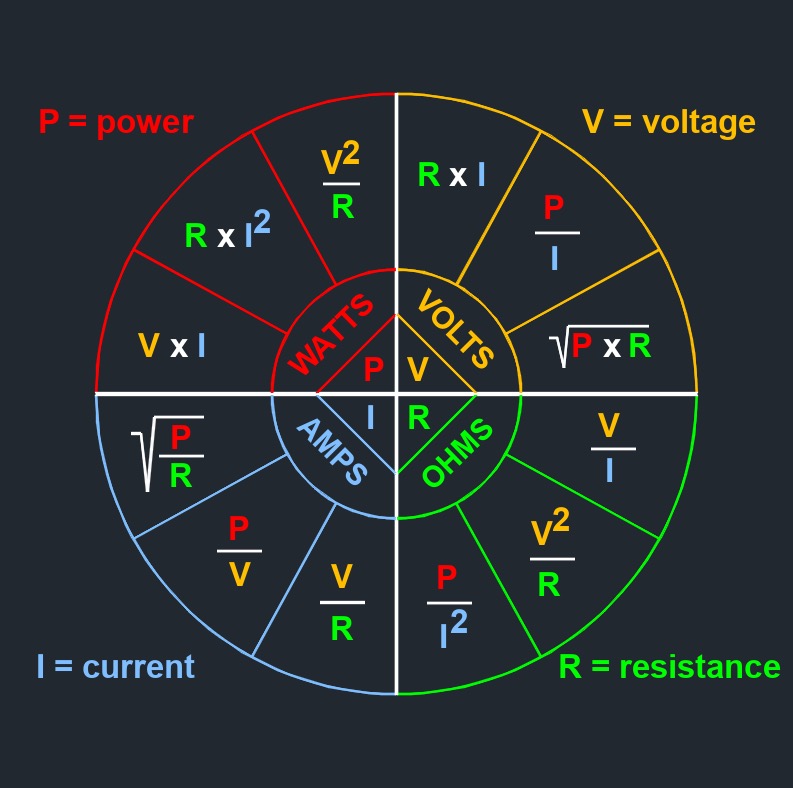Ohm's Law
Electrical Formulas |
|||
| Current | Power | Resistance | Voltage |
| \( I = V \;/\; R \) | \( P = I^2 \; R \) | \( R = V \;/\; I \) | \( V = I \; R \) |
| \( I = \sqrt{ P \;/\; R } \) | \( P = V \; I \) | \( R = P \;/\; I^2 \) | \( V = P \;/\; I \) |
| \( I = P \;/\; V \) | \( P = V^2 \;/\; R \) | \( R = V^2 \;/\; I \) | \( V = \sqrt{P\;R} \) |
Ohm's law is the relationships between power \((P)\), voltage \((V)\), current \((I)\), and resistance \((R)\).
Ohm's law is a fundamental principle in physics and electrical engineering that describes the relationship between voltage, current, and resistance in an electrical circuit. It states that the current flowing through a conductor is directly proportional to the voltage applied across it and inversely proportional to the resistance of the conductor.In simpler terms, Ohm's law states that the current flowing through a conductor is equal to the voltage across it divided by the resistance. It means that as the voltage increases, the current flowing through the conductor also increases, given that the resistance remains constant. Conversely, if the resistance increases, the current decreases for a given voltage.


Slectrical Symbols |
|||
| Quantity | Symbol | Unit | Formula |
| Capacitance | \(C\) | Farad | \(C= Q\;/\;V\) |
| Charge | \(C\) | Coulomb | \(Q= I \; t\) |
| Conductance | \(G\) | Siemen | \(G=P\;/\;V^2\) |
| Current | \(I\) | Ampere | \(I= V\;/\;R\) |
| Frequency | \(Hz\) | Hertz | \(f=1 + T\) |
| Impedance | \(Z\) | Ohm | \(Z=\sqrt{R^2 + (X_L - X_C)^2}\) |
| Inductance | \(L\;\) or \(\;H\) | Henry | \( L = \mu \; n^2 \;A\;/\;l \) |
| Power | \(P\) | Watt | \(P=V \; I\) |
| Resistance | \(R\;\) or \(\;\Omega\) | Ohm | \(R=V\;/\;I\) |
| Voltage | \(V\;\) or \(\;E\) | Volt | \(V=I \; R\) |
Electrical Units (Multipliers and Submultipliers) |
|||
| Prefix | Symbol | Multiplier | Power of Ten |
| yotto | Y | \(1,000,000,000,000,000,000,000,000\) | \(10^{24}\) |
| zetta | Z | \( 1,000,000,000,000,000,000,000\) | \(10^{21}\) |
| exa | E | \( 1,000,000,000,000,000,000\) | \(10^{18}\) |
| peta | P | \( 1,000,000,000,000,000\) | \(10^{15}\) |
| tera | T | \( 1,000,000,000,000\) | \(10^{12}\) |
| giga | G | \( 1,000,000,000\) | \(10^{9}\) |
| mega | M | \( 1,000,000\) | \(10^{6}\) |
| kilo | k | \( 1,000\) | \(10^{3}\) |
| hecto | h | \(100\) | \(10^{2}\) |
| deca | da | \(10\) | \(10^{1}\) |
| none | none | \( 1\) | \(10^{0}\) |
| deci | d | \(1\;/\;10\) | \(10^{-1}\) |
| centi | c | \(1\;/\;100\) | \(10^{-2}\) |
| milli | m | \(1\;/\;1,000\) | \(10^{-3}\) |
| micro | \(\mu\) | \(1\;/\;1,000,000\) | \(10^{-6}\) |
| nano | n | \(1\;/\;1,000,000,000\) | \(10^{-9}\) |
| pico | p | \(1\;/\;1,000,000,000,000\) | \(10^{-12}\) |
| femto | f | \(1\;/\;1,000,000,000,000,000\) | \(10^{-15}\) |
| atto | a | \(1\;/\;1,000,000,000,000,000,000\) | \(10^{-18}\) |
| zepto | z | \(1\;/\;1,000,000,000,000,000,000,000\) | \(10^{-21}\) |
| yocto | y | \(1\;/\;1,000,000,000,000,000,000,000,000\) | \(10^{-24}\) |

